Thangka painting is a unique and ancient art form closely associated with Tibetan Buddhism. It originated around the 7th century in Nepal and Tibet. Thangkas are intricate paintings that depict Buddhist deities, scenes, or mandalas, usually on cotton canvas or silk with a mixture of water-soluble pigments, both mineral and organic, glued together with a binder.
The primary purpose of Thangka paintings is not decorative but rather spiritual. These paintings serve as important teaching tools, depicting the life of the Buddha, various influential lamas, and other deities and bodhisattvas. One of the notable aspects of Thangka is its use of symbolism and vibrant colours to represent different aspects of Buddhist philosophy and teachings.
A Thangka is more than just a piece of art. It is a medium for expression and a guide for contemplative experience. It is used as a tool in spiritual practice, meditation, and rituals. The creation of a Thangka painting is itself considered a form of meditation, requiring the artist to possess deep understanding and respect for the spiritual and iconographic details.
In addition to their spiritual significance, Thangkas are also valued for their aesthetic beauty and detailed craftsmanship. The creation of a Thangka involves several meticulous steps, including preparing and priming the canvas, sketching the design, applying the paint, and often finishing with gilded details.
Today, Thangka paintings are appreciated worldwide for their artistic and cultural value. They continue to play a significant role in the preservation and dissemination of Buddhist culture and teachings.
Also Read: Unique Arts of Nepal
Origin, Historical Significance and Evolution
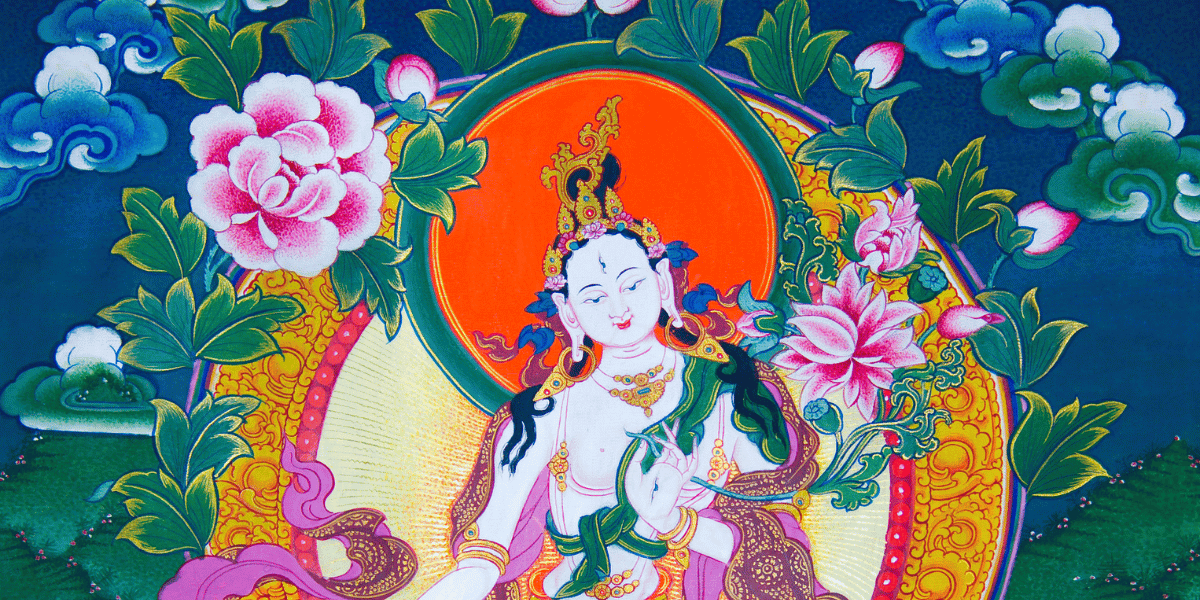
Thangka painting has deep roots in the history and culture of Buddhism, particularly in the Himalayan regions, including Tibet, Nepal, and Bhutan. Its origins can be traced back to the 7th century, emerging as a significant art form with the spread of Buddhism in these regions.
Origins:
- Early Development: Thangka painting is believed to have developed alongside the spread of Buddhism in Tibet. It was influenced by Nepalese, Chinese, and Kashmiri artistic styles due to the region's location along major trade routes.
- Indian Influence: The art form also drew heavily from Indian religious art, as Buddhism itself originated in India. Early Thangka paintings were influenced by Indian Buddhist iconography and style.
Historical Significance:
- Religious and Educational Tool: Thangkas were used primarily for religious purposes. They served as aids in teaching Buddhist concepts, with images of deities, scenes from the Buddha's life, and complex cosmological charts. They played a crucial role in spreading Buddhist teachings, especially in areas where literacy was limited.
- Spiritual Practice: Creating a Thangka was considered a meditative and spiritual practice, with artists often being monks who undertook the task as a form of religious devotion. The creation process itself was imbued with ritual and prayer.
- Cultural Preservation: Thangkas became a key medium for preserving Buddhist iconography and scriptural stories. They were a means of keeping the religion's teachings alive, especially during periods of political instability or religious persecution.
- Ritual Use: Thangkas were not just artworks but also used in Buddhist rituals and ceremonies. They were often displayed in monasteries and used in processions, serving as objects of veneration and aids to meditation.
Evolution:
- Stylistic Development: Over centuries, Thangka painting evolved, absorbing influences from various Asian art styles, leading to diverse regional variations in style, iconography, and technique.
- Patronage: The art form flourished under the patronage of nobility and religious institutions, which allowed for the development of intricate designs and the use of precious materials.
Thangka paintings, therefore, are not merely art; they are a confluence of spirituality, education, and culture, reflecting the rich tapestry of Buddhist history and thought. They continue to be an integral part of Buddhist practices and a testament to the religion's historical journey across Asia.
Importance of Thangka Paintings

In modern times, Thangka painting holds significant importance, both as a cultural heritage and as a living art form with spiritual and educational relevance. Here are some key aspects of its importance:
Cultural and Artistic Significance:
- Preservation of Tradition: Thangka paintings are a vital link to the rich cultural and artistic traditions of the Himalayan regions. They serve as a window into the past, preserving centuries-old artistic techniques and iconography.
- Global Recognition: As an art form, Thangkas have gained international recognition, appreciated for their intricate detailing, vivid colours, and unique style. This global interest helps to preserve and spread awareness of this traditional art form.
Spiritual and Educational Relevance:
- Meditative and Spiritual Tool: Thangkas continue to serve as an aid for meditation and spiritual practice in Buddhist communities. The symbolism and imagery in Thangka paintings are used to teach and internalise Buddhist philosophies and practices.
- Teaching Aid: In the context of Buddhist education, Thangkas are valuable for explaining the teachings of Buddha, stories of various deities, and complex philosophical concepts. They make these teachings accessible and visually engaging.
Economic and Social Impact:
- Livelihood for Artists: The ongoing demand for authentic Thangka paintings provides a livelihood for artists in regions where economic opportunities may be limited. It's an important source of income and a way of life for many communities.
- Cultural Tourism: Thangka paintings attract tourists interested in Buddhist culture and Himalayan art, contributing to the local economy and promoting cultural tourism.
Contemporary Adaptation:
- Modern Interpretations: Contemporary artists are adapting Thangka painting techniques to create works that address modern themes, merging traditional methods with new ideas and perspectives.
- Cross-Cultural Exchange: Through exhibitions, workshops, and cultural exchanges, Thangka paintings facilitate a cross-cultural dialogue, introducing people worldwide to Buddhist philosophy and Himalayan culture.
Preservation and Research:
- Academic Interest: Thangkas are subjects of scholarly research, offering insights into the religious, historical, and social contexts of the regions where they were created.
- Conservation Efforts: Museums and cultural institutions around the world are involved in conserving and studying Thangka paintings, ensuring their preservation for future generations.
In summary, Thangka painting in modern times transcends its traditional religious role, becoming a bridge between the past and present, East and West, and spirituality and art. It continues to inspire, educate, and foster a deeper understanding of Buddhist philosophy and Himalayan culture globally.
The Thangka Art form
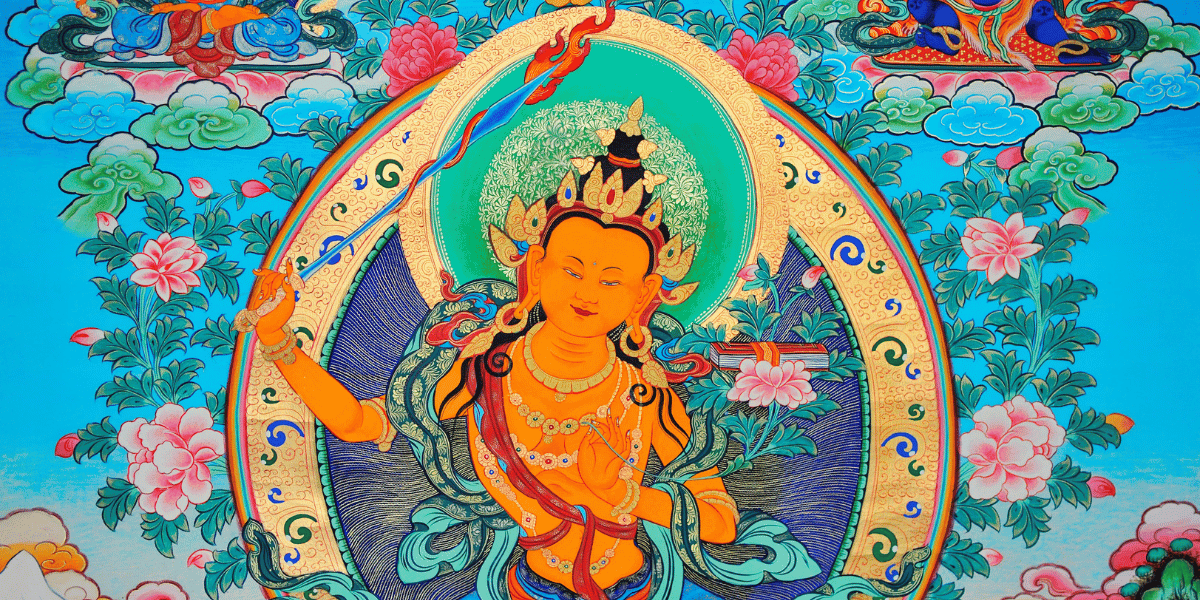
Thangka painting is a distinctive form of Buddhist art that has flourished for centuries in the Himalayan regions. It's characterised by its meticulous technique, rich iconography, and profound spiritual significance. Here's a detailed description of this art form:
Basic Composition:
- Medium: Thangkas are traditionally painted on cotton or silk fabric. The painting surface is prepared with a mixture of chalk, gesso, and a binder to create a smooth and durable base.
- Format: They typically come in a rectangular shape and are often mounted on a larger piece of silk to create an elaborate border, known as a'veil', which can be rolled up for storage or transport.
Artistic Technique:
- Iconometry: The creation of a Thangka is governed by specific guidelines known as iconometry, which ensures accurate depictions of deities according to scriptural descriptions. This involves the use of grids and specific proportions.
- Paints and Colors: The paints are traditionally made from natural, mineral-based pigments mixed with a binder. The colours are vibrant and have a deep symbolic meaning, contributing to the overall spiritual message.
- Detailing: Attention to detail is a hallmark of Thangka art. Fine lines, intricate patterns, and elaborate backgrounds are common features.
Iconography:
- Deities and Symbols: Thangkas often depict various Buddhist deities, each with distinct attributes, postures, and surroundings that symbolise different aspects of Buddhist teachings.
- Mandalas: Some Thangkas feature mandalas, complex and symmetrical diagrams that represent the spiritual universe. They serve as tools for meditation and spiritual practice.
- Scenes and Narratives: Other Thangkas portray scenes from the life of the Buddha, stories of other Buddhist saints, or cosmological charts.
Spiritual Aspect:
- Meditative Process: The creation of a Thangka is itself a form of meditation. Artists often engage in spiritual practices while creating Thangkas, imbuing the work with a sense of devotion and mindfulness.
- Use in Practice: Thangkas are not merely decorative but are used in Buddhist rituals, teachings, and meditations. They serve as visual aids to deepen understanding and spiritual practice.
Cultural Context:
- Regional Variations: While sharing common themes, Thangkas exhibit regional variations in style, reflecting the diverse cultural influences within the Himalayan regions.
- Evolution: Over time, Thangka painting has evolved, with newer styles and influences blending with the traditional.
Preservation and Continuity:
- Training and Transmission: The art of Thangka painting is passed down through generations, often within monastic communities, ensuring the continuity and preservation of this traditional art form.
Thangka painting, therefore, is much more than an art; it is a confluence of artistic skill, religious devotion, and cultural tradition, offering a window into the spiritual and philosophical world of Buddhism.
Common Themes and Symbols in Thangka Paintings
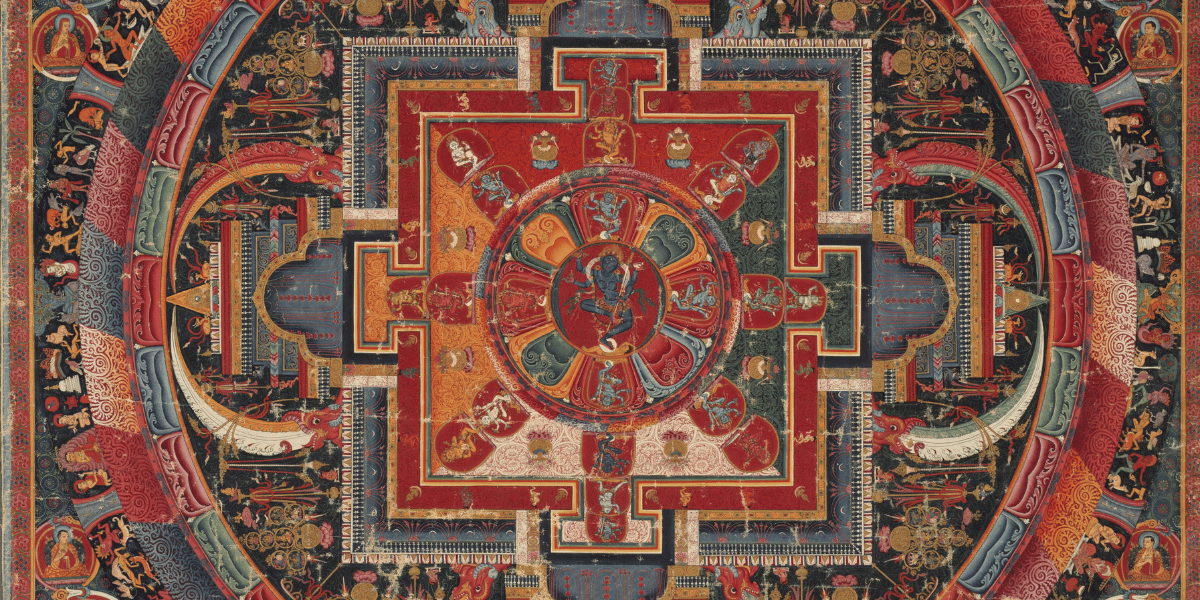
Thangka paintings are rich in symbolism, with each element carrying specific meanings and teachings from Buddhist philosophy. Understanding these common themes and symbols is key to appreciating the depth of Thangka art. Here's an overview of some of these elements:
Buddhist Deities:
- The Buddha: Depictions of the Buddha in various poses (mudras) symbolise different aspects of his life and teachings.
- Bodhisattvas: These are beings who have attained enlightenment but choose to remain in the cycle of rebirth to help others. Avalokiteshvara (compassion) and Manjushri (wisdom) are common examples.
- Dakinis and Protectors: These figures represent the energy and dynamic aspects of the divine, often appearing in wrathful forms to symbolise the destruction of obstacles on the path to enlightenment.
Mandalas:
- Cosmic Diagrams: Mandalas are geometric representations of the universe, symbolising the impermanence and interconnectedness of all things.
- Spiritual Maps: They serve as a guide for meditation, helping practitioners to visualise the path towards enlightenment.
The Wheel of Life:
- Samsara: This symbol represents the cycle of birth, death, and rebirth (samsara), with various realms and the causes of suffering depicted.
- Teachings on Karma and Liberation: The wheel often includes depictions of the twelve links in the chain of causation, illustrating how actions (karma) lead to future consequences.
Eight Auspicious Symbols:
- Lotus: Purity and enlightenment, rising unsullied from muddy waters.
- Endless Knot: Interconnectedness of all things and the continuous cycle of existence.
- Conch Shell: The spread of the Buddha's teachings.
- Parasol: Protection and royalty.
- Golden Fish: Good fortune and fertility.
- Treasure Vase: Spiritual and material abundance.
- Dharma Wheel: The Buddha's teachings and the path to enlightenment.
- Victory Banner: Triumph of the Buddha's teachings over ignorance.
Landscapes and Nature:
- Mountains: Often symbolise stability, permanence, and spiritual elevation.
- Rivers and Lakes: Can represent the flow of life, change, and the cleansing nature of teachings.
Colors:
- White: Purity and liberation.
- Red: Life force, preservation, and the power of the teachings.
- Blue: Tranquility, wisdom, and the infinite like the sky.
- Green: Activity, accomplishment, and the vibrant energy of practice.
- Yellow/Gold: Wealth, fertility, and the renunciation of materialism.
Floral Motifs:
- Peonies and Other Flowers: Symbolise the flourishing of the Dharma and the transient nature of life.
Fire and Clouds:
- Fire: Transformation and purification.
- Clouds: The divine presence and the ephemeral nature of existence.
These themes and symbols in Thangka paintings are not only artistically profound but also serve as a visual language through which Buddhist teachings and concepts are communicated. Understanding them enhances the appreciation of Thangka as a spiritual and educational tool.
Significance of Colours and Motifs

In Thangka painting, colours and motifs are deeply symbolic, carrying significant meanings rooted in Buddhist philosophy and teachings. Understanding the symbolism of these elements can provide a deeper appreciation of the art form. Here's a look at the significance of some key colours and motifs:
Significance of Colors:
- Blue: Represents tranquility, wisdom, and the infinite. Blue, especially in its deeper shades, is associated with the healing qualities of the mind and the expansiveness of the sky, symbolising openness and serenity.
- White: Symbolises purity, peace, and learning. It represents the absence of ignorance, depicted in the calm and clear nature of enlightenment and spiritual liberation.
- Red: Stands for life force, energy, strength, and the qualities of preservation. In Buddhist iconography, red often signifies the power and intensity of the enlightened mind, as well as compassion.
- Yellow/Gold: Represents richness, nourishment, and the wealth of Buddhist teachings. Gold or bright yellow often symbolises the highest state of perfection and the transformation of the ordinary into the extraordinary.
- Green: Associated with action, accomplishment, and the vibrant energy of practice. Green in Thangkas can indicate a dynamic state, representing the active and compassionate nature of the path to enlightenment.
- Black: Often used to symbolise the ultimate reality of the universe, the void, or the transcendence of the physical realm. It can also represent death, or more specifically, the death of ignorance.
Significance of Motifs:
- Lotus: A common motif in Thangkas, the lotus represents purity and enlightenment. It symbolises the idea of rising above the murky waters of materialism or attachment to reach a state of spiritual perfection.
- Endless Knot: This motif signifies the interconnectedness of all things, the endless cycle of birth and rebirth, and the infinite wisdom of the Buddha.
- Dharma Wheel (Dharmachakra): Represents the Buddha's teachings and the journey towards enlightenment. The eight spokes often symbolise the Noble Eightfold Path, a core aspect of Buddhist practice.
- Mountains: In many Thangkas, mountains are depicted as sacred abodes of deities. They symbolise stability, eternity, and spiritual elevation.
- Clouds: Represent the divine presence, the impermanence of life, and the ephemeral nature of the physical world. They can also signify the blending of the mundane with the spiritual.
- Fire: Often depicted in the aura or halo of deities, fire symbolises transformation, energy, and purification.
- Rivers and Water: Symbolise life, fluidity, and the flow of the dharma. Water can also represent purity and the cleansing of ignorance or negativity.
Each colour and motif in Thangka paintings is carefully chosen to convey specific aspects of Buddhist teachings and philosophy. These symbolic elements serve not just as artistic expressions but as tools for meditation and spiritual reflection, making Thangkas much more than mere artworks.
Process of Creating a Thangka
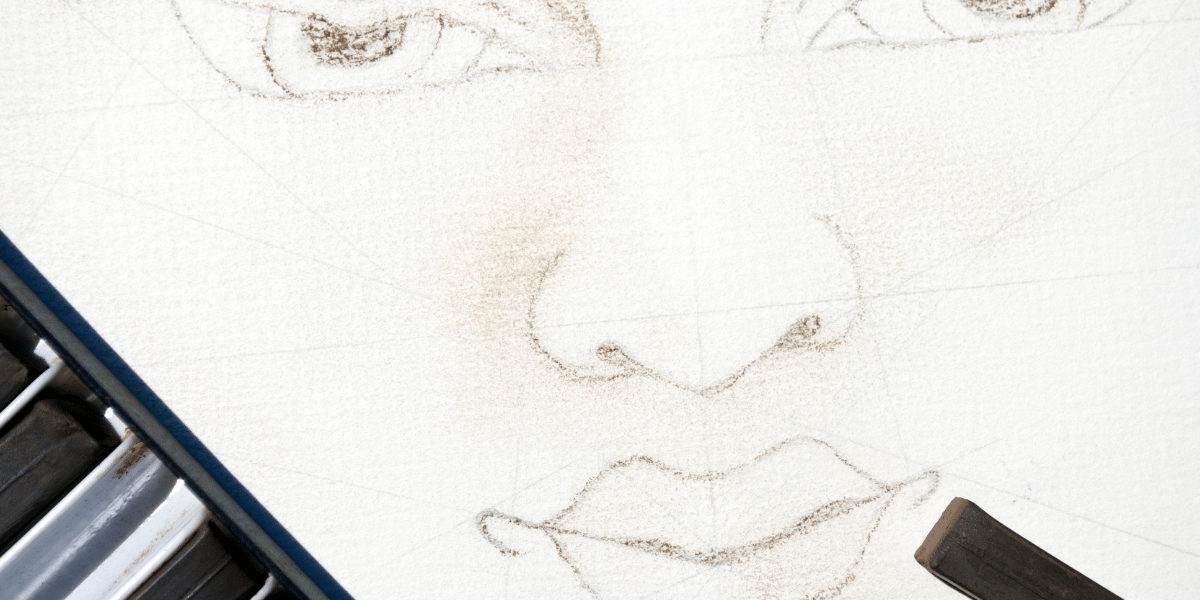
Creating a Thangka is a complex and spiritual process, involving meticulous steps that require patience, precision, and devotion. Here's a step-by-step guide to how a Thangka is traditionally created:
Preparation of the Canvas:
- Material Selection: The artist selects a piece of fine cloth, typically cotton or silk, as the base for the painting.
- Stretching the Canvas: The cloth is stretched tightly on a wooden frame to ensure a smooth and even surface.
- Applying the Ground: A mixture of chalk, gesso, and a binder is applied to the cloth to prepare it for painting. This ground provides a smooth and absorbent surface.
Drawing the Design:
- Grid Creation: A grid is drawn on the canvas using straight and curved lines. This grid helps in maintaining the correct proportions as per traditional iconometry.
- Sketching: The initial sketch is made using charcoal or pencil. This includes the primary deity, other figures, symbols, and additional elements like landscapes or architecture.
Outlining:
- Finalising Lines: Once the sketch is complete, the artist outlines the design with a fine brush and black ink or paint, solidifying the details.
Applying the Base Colours:
- Colour Selection: Colours are chosen based on the symbolic significance of each hue.
- Painting: The artist starts applying base colours to the painting, usually working from lighter to darker shades.
Detailing:
- Layering: Additional layers of paint are added to create depth and detail. This step requires great skill to achieve the fine details typical of Thangka paintings.
- Gold Application: In many Thangkas, gold is applied to highlight certain elements, especially deities, adding a luminous quality to the painting.
Adding Final Details:
- Intricate Work: Fine details like facial features, jewellery, and intricate patterns in the clothing are carefully painted.
- Symbols and Text: Additional symbols, inscriptions, or mantras may be added as per the thematic requirements of the Thangka.
Cutting and Mounting:
- Removal from Frame: The painting is carefully removed from the frame.
- Mounting: The Thangka is then traditionally mounted on a larger piece of silk fabric, creating an elaborate border around the painting. This also includes a cover, usually silk, which protects the painting when rolled up.
Consecration:
- Spiritual Activation: Finally, the Thangka is often consecrated by a Buddhist monk, who blesses it and activates its spiritual power. This step infuses the Thangka with religious significance.
The creation of a Thangka is not just a matter of artistic skill; it is a devotional act. The artist engages in spiritual practices throughout the process, making the creation of a Thangka a meditative and sacred act.
Materials used in Traditional Thangka Painting
.png)
Traditional Thangka painting employs a variety of specialised materials, each chosen for its quality and significance. These materials are often natural and have been used for centuries, reflecting the art form's deep connection to its cultural and spiritual roots. Here's a list of key materials used in traditional Thangka painting:
Canvas Material:
- Cotton or Silk: The base for the painting is usually a piece of fine cotton or silk fabric. The choice depends on the desired texture and the intricacy of the painting.
Preparation Materials:
- Chalk Powder or Gesso: Used to create a smooth, white ground on the fabric. This mixture provides an even and absorbent surface for painting.
- Animal Glue or Binder: A natural adhesive, often made from animal hide, is mixed with chalk or gesso to bind the ground to the fabric.
Drawing and Outlining Tools:
- Charcoal or Pencil: For sketching the initial design on the prepared canvas.
- Ink: Fine black ink is used for outlining the sketches.
Paints:
- Natural Pigments: Traditional Thangka paintings use natural pigments made from minerals, plants, and sometimes precious stones. These pigments are ground into a fine powder and mixed with a binding medium.
- Organic Colors: Some colours are derived from organic sources, such as indigo for blue or malachite for green.
Binding Medium for Paints:
- Animal glue or Plant resins: These natural binders are mixed with pigments to create the paint. They ensure that the paint adheres to the canvas and has a durable finish.
Gold:
- Gold Leaf or Powder: Gold is often used in Thangka paintings, either as leaf or powdered gold, to highlight certain elements, especially on deities or symbolic objects.
Brushes:
- Fine Brushes: Made traditionally from animal hair (such as sable), these brushes are crucial for the detailed and intricate work characteristic of Thangka paintings.
Mounting Materials:
- Silk Fabric: Used for the mounting and framing of the completed Thangka. Silk borders and veils are often elaborately decorated and serve as a protective cover.
- Wooden Dowels: Used at the top and bottom of the Thangka for mounting and to allow it to hang properly.
Other Materials:
- Varnish or Protective Coatings: Occasionally used to protect the finished painting.
The use of these traditional materials adds to the sacredness and authenticity of Thangka paintings. The process of preparing and applying these materials is often seen as a meditative and spiritual practice in itself, imbuing the artwork with deeper meaning and value.
Role of Meditation and Spirituality in Creating Thangkas
The creation of a Thangka painting is deeply intertwined with meditation and spirituality, making it a uniquely sacred art form. The process is as much about spiritual practice as it is about artistic skill. Here are some key aspects of how meditation and spirituality play a role in the creation of a Thangka:
Intention and Mindfulness:
- Spiritual Intention: The artist begins with a clear spiritual intention, often dedicating the work to the enlightenment of all beings. This sets a tone of mindfulness and purpose throughout the creative process.
- Meditative Approach: The act of painting is approached as a meditative practice. The artist maintains a state of mindfulness, focusing on the present moment and the task at hand, which is considered a form of meditation.
Purification and Preparation:
- Personal Purification: Before starting, the artist often engages in purification rituals, such as meditation, fasting, or prayers, to cleanse their mind and heart.
- Sacred Space: The workspace is treated as a sacred space. It is not uncommon for the artist to set up an altar and perform rituals to invoke blessings and create a conducive spiritual environment.
Concentration and Visualisation:
- Focused Concentration: The intricate and detailed nature of Thangka painting requires a high level of concentration, akin to a meditative state.
- Visualization: Artists often visualise the deity or the scene they are painting, not just as an image but as a living entity. This visualisation process is a key part of the spiritual practice, helping to imbue the Thangka with sacred energy.
Mantras and Prayers:
- Incorporation of Mantras: While painting, especially the figures of deities or sacred symbols, the artist may recite mantras or prayers. This is believed to charge the Thangka with spiritual power and blessings.
- Prayer for Guidance: Prayers for guidance and accuracy in depicting sacred figures are common, as it’s believed that an accurate depiction is crucial for the Thangka’s spiritual efficacy.
Connection with the Divine:
- Spiritual Channeling: The artist often seeks to become a channel for the divine, allowing spiritual energy to guide their hand. This is seen as a way of ensuring the authenticity and sacredness of the painting.
- Offering to the Divine: The completed Thangka is often viewed not merely as a piece of art but as an offering to the divine, a manifestation of devotion and spiritual practice.
Consecration:
- Blessing Ceremony: Once completed, a Thangka is typically consecrated by a Buddhist monk or teacher, who performs rituals to invoke the presence of the depicted deities and bless the Thangka.
In essence, the creation of a Thangka is a deeply spiritual journey, not just for the artist but for the Thangka itself. It is a fusion of art, meditation, and devotion, resulting in a work that is both visually stunning and spiritually potent.
Prominent Thangka Artists
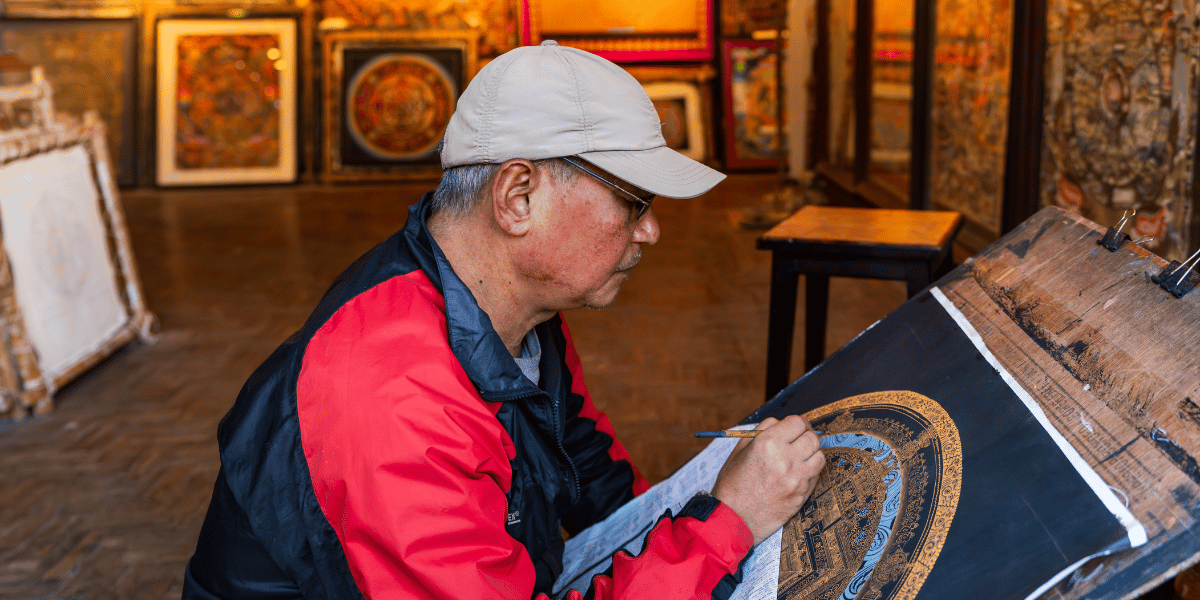
Thangka painting, deeply rooted in the religious and cultural traditions of the Himalayas, has been practiced by numerous artists over centuries. While many Thangka artists traditionally remained anonymous, considering their work a form of spiritual practice rather than a means of personal expression, there are some notable artists and schools that have gained recognition for their unique styles and contributions to the art form. Here's an introduction to some famous Thangka artists and their distinctive styles:
Tashi Norbu:
- Modern Fusion: Tashi Norbu, a contemporary Tibetan artist, integrates traditional Thangka painting techniques with modern elements. His work often includes Western artistic influences, which he uses to convey traditional Buddhist themes in a contemporary context.
Sidkar Gyatso (Also known as Thangka Sidkar):
- Early 20th Century Master: Gyatso was known for his intricate details and vibrant colours. His works are considered a benchmark in Thangka painting, especially for the portrayal of Buddhist deities and complex iconography.
Menlha Dhondup:
- Traditional Excellence: A well-respected contemporary Thangka artist known for his adherence to traditional methods and styles. His work is characterised by precise detailing and a deep understanding of Buddhist iconography.
Samten Dakpa:
- Innovative and Devotional: A modern artist who combines traditional techniques with innovative designs, often focusing on the spiritual and meditative aspects of Thangka art.
Pema Namdol Thaye:
- Cross-Cultural Approach: Pema Namdol Thaye is known for his skilful blend of traditional Thangka painting techniques with influences from other cultural art forms, creating a unique and diverse artistic expression.
Khamtrul Rinpoche III, Ngawang Kunga Tenzin:
- A Monk and Artist: Known for his spiritual approach to Thangka painting, Khamtrul Rinpoche's works are revered for their deep meditation on Buddhist philosophy and teachings.
Each of these artists has contributed significantly to the development and preservation of Thangka painting. Their work not only showcases the artistic brilliance and meticulous skill required for Thangka painting but also highlights the deep spiritual and religious significance of this art form. The diversity in their styles reflects the rich tapestry of Buddhist art and the evolving nature of Thangka painting across different regions and times.
Prominent Thangka Schools and Teachings
Thangka painting, rich in history and tradition, has given rise to various schools and styles, each with its own unique characteristics. These schools often reflect the cultural and regional influences of the areas in which they developed. Here's an overview of some of the prominent schools of Thangka painting:
Menri School:
- Origin: This is one of the oldest schools of Thangka painting, originating in the 15th century in Tibet.
- Characteristics: Menri style is known for its precise and balanced compositions, adherence to iconometric guidelines, and fine detailing. It often features serene faces and a calm, composed demeanour in the figures.
New Menri School:
- Development: This style evolved from the Menri School and gained prominence in the 17th century.
- Features: The New Menri School is characterised by a greater emphasis on realism and softer, more lifelike depictions of figures. It also displays more dynamic compositions and a vivid colour palette.
Karma Gadri School:
- Background: Emerging in the 16th century in Eastern Tibet, this school is part of the Karma Kagyu tradition.
- Style: Known for spacious and peaceful compositions with extensive landscapes, the Karma Gadri style combines elements of both Indian and Chinese artistic influences. It often features less crowded compositions and a serene, open ambience.
Sakyapa School:
- Origin: Rooted in the Sakya tradition, this school dates back to the 13th century.
- Distinctive Qualities: The Sakyapa School is known for its elaborate use of gold and detailed depiction of ornamental motifs. The style is regal and sophisticated, with a strong emphasis on the iconography of deities.
Kagyu School:
- Tradition: Associated with the Kagyu sect of Tibetan Buddhism, this school has a strong spiritual focus.
- Artistic Features: The Kagyu School's Thangkas are often characterised by their emphasis on the spiritual and meditative aspects of the subjects. They tend to have a more austere and subdued style compared to other schools.
Gelugpa School:
- Foundation: The Gelugpa School, aligned with the Gelug sect, was established in the 14th century.
- Characteristics: This style is known for its strict adherence to iconographic details and a high level of precision in the depiction of religious figures. The use of bold colours and intricate details is common.
Nyingma School:
- Heritage: As the oldest school of Tibetan Buddhism, the Nyingma tradition has a distinct style.
- Features: Nyingma Thangkas often depict ancient masters and deities specific to the Nyingma lineage. They are notable for their depth of symbolism and often use darker, more earthy colours.
Each of these schools of Thangka painting offers a window into the diverse expressions of Buddhist art and iconography. The variations in style, technique, and focus reflect the rich tapestry of Tibetan Buddhist practice and the cultural influences of different regions. Thangka paintings from these schools are not only treasured for their aesthetic beauty but also for their deep spiritual and religious significance.
Different Techniques and Symbolism Taught
The various schools of Thangka painting differ in their techniques, symbolism, and stylistic emphasis, reflecting the diverse cultural and spiritual landscapes of the regions where they developed. Here's a comparison of how these schools differ in technique and symbolism:
Menri School:
- Technique: Menri paintings are known for their strict adherence to traditional iconometric principles, resulting in precise and symmetrical compositions.
- Symbolism: The Menri style often depicts serene deities with compassionate expressions, symbolising inner peace and spiritual maturity.
New Menri School:
- Technique: This school introduced more realistic and softer depictions, using subtle gradations of colour and light to create a sense of depth.
- Symbolism: The New Menri style tends to emphasise the approachability and human-like qualities of the deities, making the divine more relatable.
Karma Gadri School:
- Technique: Characterised by spacious compositions with less crowded figures and a significant emphasis on landscapes, reflecting Chinese artistic influences.
- Symbolism: The open spaces and serene landscapes in Karma Gadri Thangkas symbolise the vastness of the Buddhist universe and the concept of emptiness.
Sakyapa School:
- Technique: This style is known for its elaborate use of gold and detailed ornamental motifs, creating a regal and ornate appearance.
- Symbolism: The extensive use of gold and intricate details signify the richness and profundity of the Buddhist teachings and the divine nature of the deities.
Kagyu School:
- Technique: The Kagyu style often features more austere and simple compositions, focusing on the spiritual essence rather than ornamental detail.
- Symbolism: The simplicity and subdued nature of the Kagyu Thangkas reflect the sect’s emphasis on meditation and inner experiences.
Gelugpa School:
- Technique: Known for its precise and meticulous detailing and the use of vibrant colours.
- Symbolism: The intricate details and bold colours are indicative of the intellectual depth and clarity of the Gelug teachings.
Nyingma School:
- Technique: Uses darker, more earthy colours and often includes ancient masters and specific deities of the Nyingma lineage.
- Symbolism: The darker colours and depictions of ancient masters symbolise the ancient roots of the Nyingma tradition and its deep mystical aspects.
These differences in technique and symbolism not only illustrate the diversity within Thangka painting but also reflect the philosophical and doctrinal variations within Tibetan Buddhism. Each school, through its unique style, contributes to the rich tapestry of Buddhist art, offering insights into the spiritual and cultural dimensions of the regions and sects they represent.
Thangka Painting in Modern Context
Thangka painting, with its rich heritage and intricate symbolism, has had a significant influence on contemporary art, both within and beyond the realms of Buddhist cultures. This influence manifests in various ways:
Integration in Modern Artistic Practices:
- Cultural Fusion: Contemporary artists often blend Thangka techniques and motifs with modern art styles, creating a fusion that bridges traditional and contemporary aesthetics.
- Global Exposure: As Thangka art gains global attention, it inspires artists worldwide, leading to its elements being incorporated in various forms of modern art.
Influence on Conceptual Art:
- Spiritual Themes: The spiritual and philosophical depth of Thangka paintings influences contemporary conceptual artists who explore themes of spirituality, mindfulness, and interconnectedness.
- Symbolism: The rich symbolism in Thangkas provides a wealth of inspiration for artists to draw from, especially those interested in embedding deeper meanings and narratives in their work.
Impact on Design and Fashion:
- Motifs and Patterns: The intricate motifs and vibrant colors of Thangka paintings have been adapted in modern fashion and design, influencing textiles, clothing, and interior design.
- Fusion Fashion: Designers often use Thangka motifs in contemporary fashion, blending ancient symbols with modern styles.
Digital and Multimedia Art:
- Digital Interpretations: With the advent of digital art, Thangka's motifs and styles are being reinterpreted in digital formats, making them accessible and appealing to a broader, tech-savvy audience.
- Multimedia Installations: Artists are incorporating elements of Thangka in multimedia art installations, often blending traditional imagery with modern technology to create immersive experiences.
Therapeutic and Healing Arts:
- Mindfulness and Meditation: The meditative aspect of Thangka painting has influenced contemporary therapeutic arts, where the process of creating art is used as a means of meditation and stress relief.
- Art Therapy: Elements of Thangka art are used in art therapy, utilising the process of painting or interpreting symbols for psychological healing and personal growth.
Influence on Illustration and Graphic Design:
- Visual Narratives: The narrative aspect of Thangka paintings, where stories and teachings are visually depicted, influences modern illustration and graphic design.
- Iconography: The iconography of Thangkas provides a rich source of inspiration for graphic designers in creating logos, icons, and other design elements.
Educational and Cultural Projects:
- Cultural Preservation: Contemporary artists and educational projects use Thangka art to promote and preserve cultural heritage, especially in regions where traditional art forms are at risk of being forgotten.
- Cross-Cultural Exchange: Exhibitions and collaborations featuring Thangka art encourage cross-cultural exchange and understanding, broadening the global appreciation of this traditional art form.
In essence, Thangka painting's influence on contemporary art is multifaceted, spanning artistic styles, mediums, and even purposes. It serves as a bridge between the ancient and the modern, the spiritual and the artistic, enriching the global art landscape with its profound symbolism and timeless beauty.
Role of Thangka in Preservation of Buddhist culture

Thangka painting plays a crucial role in the preservation of Buddhist culture, serving as both a visual archive and a living tradition that actively contributes to the cultural and spiritual continuity of Buddhism. Here's an overview of how Thangka painting contributes to this preservation:
Visual Representation of Buddhist Teachings:
- Iconography: Thangka paintings are rich in Buddhist iconography, visually representing a wide array of deities, symbols, and teachings. This makes them vital tools for preserving and conveying complex philosophical concepts and narratives.
- Educational Tool: For centuries, Thangkas have been used to educate and instruct about Buddhist history, philosophy, and ethics, particularly in regions where literacy was not widespread.
Spiritual Practice and Ritual:
- Aid in Meditation: Thangkas are used as aids in meditation and spiritual practice, helping practitioners to visualise and internalise Buddhist teachings. This usage maintains the relevance of traditional art in contemporary spiritual practice.
- Ritual Use: Thangkas are integral to various Buddhist rituals and ceremonies, reinforcing their importance in the religious and cultural life of Buddhist communities.
Cultural Continuity and Identity:
- Preservation of Artistic Traditions: The creation of Thangka paintings involves traditional techniques and styles passed down through generations. By maintaining these practices, Thangka art helps preserve a significant aspect of Buddhist cultural heritage.
- Symbol of Cultural Identity: In Tibetan and Himalayan communities, Thangkas are a key expression of cultural identity, embodying the spiritual, historical, and artistic heritage of these regions.
Transmission of Skills and Knowledge:
- Apprenticeship and Learning: The traditional method of learning Thangka painting through apprenticeship ensures the transmission of skills, knowledge, and spiritual values to new generations of artists.
- Workshops and Schools: The establishment of Thangka painting schools and workshops, often under the auspices of monasteries or cultural institutions, plays a vital role in preserving this art form.
Inter-cultural Dialogue and Exchange:
- Global Exposure: International exhibitions and collaborations involving Thangka paintings have increased awareness and appreciation of Buddhist culture worldwide, promoting cross-cultural dialogue and understanding.
- Adaptation and Evolution: As Thangka art influences and is influenced by other artistic traditions, it becomes a dynamic medium through which Buddhist culture interacts with and adapts to the global cultural landscape.
Tourism and Economic Support:
- Cultural Tourism: Thangka paintings attract tourists and art enthusiasts, supporting local economies and increasing interest in Buddhist culture and history.
- Support for Artisan Communities: The production and sale of Thangkas provide economic support for artisan communities, helping sustain their way of life and cultural practices.
In summary, Thangka painting is not just an art form but a vital component of Buddhist cultural preservation. It encapsulates the essence of Buddhist teachings, history, and traditions, ensuring their continued relevance and transmission in a rapidly changing world.
Challenges and Adaptations in the Modern World
Thangka painting, like many traditional art forms, faces several challenges in the modern world, but it has also adapted in various ways to maintain its relevance and survival. Understanding these challenges and adaptations is key to appreciating the current state and future prospects of Thangka art.
Challenges:
- Globalisation and Cultural Shifts: The spread of global culture and modernisation has led to a decline in traditional practices and a shift in cultural values, impacting the traditional base of Thangka art.
- Commercialisation: The growing demand for Thangkas as commercial art objects rather than as spiritual tools sometimes leads to a compromise in quality and authenticity.
- Loss of Traditional Skills: The transmission of the intricate skills and knowledge required for authentic Thangka painting is at risk as fewer young people choose to pursue traditional arts.
- Economic Viability: Making a living as a Thangka artist can be challenging, leading to a decline in the number of practitioners.
- Changing Religious Practices: Modernisation and changing lifestyles may lead to a reduced role of traditional religious practices and art forms in daily life.
Adaptations:
- Incorporation of Modern Themes and Styles: Some artists are blending traditional Thangka techniques with contemporary themes and styles, creating artworks that appeal to modern aesthetics while maintaining traditional craftsmanship.
- Education and Workshops: Institutions and individual artists are organising workshops and educational programmes to teach Thangka painting, both to preserve the tradition and to adapt it to contemporary contexts.
- Online Platforms and Global Market: The use of online platforms for selling and promoting Thangkas has opened up new markets, allowing artists to reach a global audience.
- Artistic Collaborations and Exhibitions: Collaborations with artists from other disciplines and participation in international art exhibitions have helped to increase the visibility and appreciation of Thangka art worldwide.
- Cultural Tourism: The promotion of cultural tourism centred around Thangka art helps support and sustain the communities involved in this craft.
- Support from Cultural Institutions: Support from museums, cultural institutions, and governments for the preservation and promotion of Thangka painting has been crucial in keeping the tradition alive.
- Adaptation in Religious Practices: In religious contexts, there’s an adaptation to contemporary needs, with Thangkas being used in more accessible, modern ways while maintaining their spiritual significance.
In summary, while Thangka painting faces challenges due to modernisation, commercialisation, and cultural shifts, it is also finding new pathways to adapt and thrive. These adaptations not only help preserve this ancient art form but also allow it to evolve and remain a relevant and vibrant part of cultural and spiritual life.
Spiritual and Healing Aspects of Thangka
Thangka paintings hold a special place in Buddhist practices, particularly in meditation and healing. These intricately detailed paintings are not just artistic expressions but also tools for spiritual development and psychological well-being. Here's how Thangka paintings are used in these contexts:
Use in Meditation:
- Visual Aids for Concentration: Thangkas often serve as focal points during meditation. The detailed imagery helps practitioners concentrate and steady their minds.
- Aids in Visualisation Practices: In Tibetan Buddhism, visualisation is a key meditation technique. Practitioners visualise themselves as deities or contemplate the intricate details of a mandala to embody the qualities these images represent. Thangkas provide a precise visual reference for these practices.
- Symbolic Representation: The symbols and images in Thangkas are rich in spiritual meaning. Meditating on these symbols can help practitioners internalise deeper Buddhist teachings.
- Creation as Meditation: The process of creating a Thangka itself is a form of meditation. Artists often engage in mindfulness and contemplative practices while painting, imbuing the Thangka with spiritual energy.
Use in Healing:
- Psychological and Emotional Healing: The symbolic nature of Thangkas can have a therapeutic effect. The act of meditating on these paintings can help individuals cope with emotional distress, anxiety, and mental turmoil.
- Spiritual Healing: Thangkas are believed to possess spiritual power. In some Buddhist traditions, they are used in rituals and ceremonies intended for healing and spiritual purification.
- Fostering a Healing Environment: Thangkas are often used to create a serene and spiritually charged atmosphere in healing centres, meditation halls, and even homes. This environment can aid in mental and emotional well-being.
- Visualisation for Physical Healing: Some healing practices involve visualising the healing energies or deities depicted in Thangkas and channelling these energies to the individual in need of healing.
- Mind-Body Connection: The intricate details and patterns in Thangka art can help focus the mind, leading to a state of calm and relaxation that supports physical healing.
- Cultural and Spiritual Comfort: For individuals within the Buddhist tradition, the presence of Thangka paintings can provide a sense of cultural and spiritual comfort, reinforcing a connection to their spiritual path and community, which can be healing in itself.
In summary, Thangka paintings are much more than aesthetic objects; they are integral to certain Buddhist meditation and healing practices, providing focus, inspiration, and a means of accessing deeper spiritual states. Their use in these contexts underscores the interconnectedness of art, spirituality, and well-being in Buddhist traditions.
Psychological Impact of Thangka Art
The psychological impact of Thangka art extends beyond its aesthetic appeal, touching upon deeper aspects of the human psyche and emotional well-being. This impact can be seen in several ways:
Facilitating Meditation and Mindfulness:
- Aid in Focus: The intricate details and symbolic imagery in Thangkas help in focusing the mind, making them effective tools in meditation practices. This focused attention can lead to enhanced mindfulness, reducing symptoms of stress and anxiety.
- Visualisation Tool: In practices where visualisation is essential, Thangkas serve as detailed guides, helping to create vivid mental images that can deepen meditation experiences.
Emotional Resonance:
- Spiritual Connection: For practitioners and followers of Buddhism, Thangka paintings can evoke a strong emotional and spiritual resonance, providing a sense of peace and connectedness to their beliefs and practices.
- Aesthetic Appreciation: Even for those not adhering to Buddhist practices, the beauty and artistry of Thangka paintings can evoke feelings of awe and wonder, contributing to emotional well-being.
Cultural and Spiritual Education:
- Learning and Insight: Thangkas often depict stories and teachings from Buddhist philosophy. Engaging with these narratives can provide psychological insights and foster a deeper understanding of oneself and the world.
- Cultural Connection: For those connected to the cultures where Thangka art originated, these paintings can strengthen cultural identity and heritage, contributing to a sense of belonging and self-esteem.
Therapeutic Uses:
- Art Therapy: The process of creating or engaging with Thangka art can be therapeutic. It can be a form of expression and self-exploration, aiding in the processing of emotions and experiences.
- Healing Environment: The presence of Thangka paintings in therapeutic settings can create a calming and focused environment conducive to healing.
Promoting Positive Qualities:
- Inspiration for Positive Traits: The deities and symbols in Thangka paintings often represent positive qualities like compassion, wisdom, and patience. Contemplating these images can inspire individuals to cultivate these traits in their own lives.
- Modelling Meditation and Virtue: By depicting idealised spiritual states and virtuous actions, Thangkas can serve as models for meditation and ethical conduct.
Coping with Life Challenges:
- Symbolic Representation of Struggle: Certain Thangkas depict the struggles and obstacles on the path to enlightenment, offering viewers a symbolic way to relate to and understand their personal struggles.
- Source of Solace and Strength: For many, Thangka paintings provide spiritual solace and strength, particularly in times of difficulty or distress.
In conclusion, Thangka art's psychological impact is multifaceted, offering benefits that range from mental focus and emotional healing to spiritual inspiration and cultural connection. Its value lies not just in its visual beauty but in its ability to touch and transform the human mind and spirit.
Preserving the Art of Thangka Painting
Efforts to conserve and promote Thangka painting are multifaceted and involve various stakeholders, including artists, cultural institutions, governments, and international organisations. These efforts are crucial in ensuring that this ancient art form continues to thrive and adapt in the modern world. Here's an overview of some of these key efforts:
Artisan Training and Workshops:
- Traditional Apprenticeships: Many Thangka artists continue to train apprentices in the traditional way, ensuring the transfer of skills and knowledge to new generations.
- Educational Workshops: Institutions and individual artists conduct workshops, both in their regions of origin and internationally, to teach Thangka painting techniques and its philosophical background.
Cultural Institutions and Museums:
- Exhibitions and Collections: Museums around the world, including those in the Himalayan regions and in the West, hold collections of Thangka paintings, showcasing them in exhibitions that educate the public about this art form.
- Conservation Efforts: These institutions often have conservation departments dedicated to preserving antique Thangkas, ensuring their longevity and historical integrity.
Government and Non-Governmental Initiatives:
- Cultural Preservation Programs: In countries like Nepal, Bhutan, and Tibet, government and non-governmental organisations have initiated programmes to preserve and promote traditional arts, including Thangka painting.
- Grants and Funding: Various organisations provide grants and funding to support artists, exhibitions, and educational initiatives related to Thangka art.
International Collaboration and Exhibitions:
- Cross-Cultural Projects: Collaborative projects and international exhibitions play a significant role in raising awareness about Thangka painting globally.
- Cultural Exchange Programs: Exchange programmes between artists and institutions help in sharing knowledge and skills and in integrating Thangka art into broader art conversations.
Online Platforms and Digitalization:
- Digital Galleries and Online Sales: The digitalisation of Thangka art and the use of online platforms for sales have made it more accessible to a global audience.
- Digital Archiving: Efforts to digitalise collections of Thangka paintings help in their preservation and provide researchers and enthusiasts worldwide access to these artworks.
Community Engagement and Tourism:
- Cultural Tourism: Promoting Thangka painting as part of cultural tourism helps sustain the communities that create these artworks.
- Local Markets and Fairs: Local markets and art fairs often feature Thangka paintings, supporting the livelihoods of the artists and keeping the tradition alive within communities.
Educational Integration:
- Inclusion in Academic Curriculum: Some educational institutions, particularly in regions where Thangka painting is part of cultural heritage, include it in their curriculum, educating students about its significance and techniques.
Support for Artisans:
- Fair Trade Practices: Ensuring fair compensation and support for Thangka artists helps sustain their livelihood and encourages the continuation of the tradition.
These efforts collectively contribute to both the preservation of the traditional aspects of Thangka painting and its evolution in the contemporary world. By addressing challenges such as the loss of traditional skills and the impact of commercialisation, these initiatives help ensure that Thangka painting remains a vibrant and meaningful art form.
Role of Museums and Cultural Institutions
.png)
Museums and cultural institutions play a pivotal role in the preservation, promotion, and evolution of Thangka painting. Their contributions are multifaceted and crucial in ensuring that this traditional art form continues to be accessible and relevant in the modern world. Here’s an overview of their roles:
Conservation and Preservation:
- Artefact Preservation: Museums are responsible for the physical preservation of Thangka paintings, employing specialised techniques to ensure these delicate artworks withstand the test of time.
- Preventive Conservation: This includes controlling environmental factors such as light, humidity, and temperature, which are critical for the preservation of Thangkas.
Research and Documentation:
- Academic Research: Museums conduct scholarly research on Thangka paintings, contributing to a deeper understanding of their historical, cultural, and religious contexts.
- Cataloguing and Archiving: Detailed documentation and archiving of Thangka collections provide valuable resources for researchers, historians, and enthusiasts.
Exhibitions and Displays:
- Public Exhibitions: Museums curate exhibitions that showcase Thangka paintings, often providing interpretative information to help visitors understand the art form’s cultural and spiritual significance.
- Travelling Exhibits: Some institutions organise travelling exhibits, which help in bringing Thangka art to a wider audience.
Educational Programs:
- Workshops and Seminars: Many museums and cultural institutions host educational programmes, workshops, and seminars on Thangka art, teaching about its history, techniques, and symbolism.
- Educational Materials: Development of educational materials and resources, including catalogues, books, and digital content, helps spread knowledge about Thangka paintings.
Cultural Promotion and Outreach:
- Cultural Events: Hosting cultural events and festivals that include Thangka art helps in promoting the cultural heritage associated with these paintings.
- Community Engagement: Engaging with communities, especially those where Thangka art originates, supports the living tradition and its practitioners.
Supporting Contemporary Artists:
- Artist Collaborations: Collaborations with contemporary Thangka artists for exhibitions or residencies help keep the tradition alive and evolving.
- Financial Support: Providing grants or financial support for Thangka artists and artisans aids in sustaining their craft.
Global and Cross-Cultural Exchange:
- International Collaborations: Museums often collaborate with institutions from different countries, facilitating a cross-cultural exchange of art and ideas.
- Digital Access: Providing digital access to collections via online galleries or virtual tours makes Thangka art globally accessible.
Advocacy and Cultural Preservation:
- Advocacy for Cultural Heritage: Cultural institutions advocate for the preservation of Thangka painting as an important cultural heritage, sometimes influencing policy and funding decisions.
In summary, museums and cultural institutions are guardians of Thangka painting’s rich legacy. Through their efforts in conservation, research, education, and promotion, they play a critical role in ensuring that this ancient art form continues to be celebrated and preserved for future generations.
Relevance of Thangka in Today's World
The relevance of Thangka painting in today's world extends across various dimensions, demonstrating how this traditional art form continues to offer value and significance in a modern context:
Cultural Preservation and Identity:
- Cultural Heritage: Thangka painting is a vital link to the cultural and artistic heritage of the Himalayan regions, helping to preserve unique traditions in an increasingly globalised world.
- Cultural Identity: For communities in Tibet, Nepal, and Bhutan, Thangka serves as a symbol of cultural identity, anchoring them to their historical and spiritual roots.
Spiritual and Mental Well-being:
- Mindfulness and Meditation: The practice of Thangka painting and the contemplation of its imagery can promote mindfulness and meditation, offering a counterbalance to the fast-paced and often stressful modern lifestyle.
- Therapeutic Use: Thangka art's intricate designs and spiritual themes find relevance in therapeutic settings, aiding in mental and emotional healing.
Artistic and Aesthetic Appreciation:
- Global Artistic Influence: Thangka painting has influenced artists around the world, contributing to a cross-cultural artistic dialogue and inspiring new forms of creative expression.
- Aesthetic Value: The aesthetic beauty of Thangka paintings, with their vibrant colours and intricate details, continues to captivate audiences, enriching the global art landscape.
Education and Learning:
- Educational Tool: Thangkas serve as educational resources, offering insights into Buddhist philosophy, history, and iconography, thus aiding in the study and dissemination of Buddhist teachings.
- Cross-Cultural Education: They provide a visual means to understand and appreciate the cultural and philosophical aspects of the regions where Buddhism is practiced.
Contemporary Adaptation and Fusion:
- Modern Interpretations: Artists are adapting Thangka paintings to reflect contemporary themes and ideas, making them relevant to current societal and cultural narratives.
- Integration with Modern Art: The fusion of Thangka motifs and techniques with modern art forms demonstrates its adaptability and ongoing evolution.
Economic Impact:
- Support for Artisans: The production and sale of Thangka paintings support the livelihoods of artisans in the Himalayan regions, contributing to the local economy.
- Cultural Tourism: Thangka art attracts tourists and art enthusiasts, fostering cultural tourism and economic development in these regions.
Global Awareness and Unity:
- Promoting Cultural Understanding: As Thangka art gains international exposure, it promotes understanding and appreciation of Buddhist and Himalayan cultures, contributing to global cultural unity and awareness.
In summary, Thangka painting’s relevance in today’s world lies in its ability to bridge the past and the present, the spiritual and the secular, the local and the global. It remains a vibrant and dynamic art form, offering spiritual enrichment, cultural insight, and artistic inspiration, even in the context of a rapidly changing modern world.
Thangka Art Essence
Thangka painting is a highly significant art form rooted in the Buddhist traditions of the Himalayan regions, particularly Tibet, Nepal, and Bhutan. Its importance is multifaceted, encompassing religious, cultural, artistic, and educational aspects:
Spiritual and Religious Significance: Thangkas are deeply ingrained in Buddhist spirituality and religious practices. They serve as visual representations of Buddhist deities, teachings, and cosmology, aiding in meditation, teaching, and ritual practices.
Cultural Heritage: Thangka paintings are a vital part of the cultural heritage of the Himalayan regions. They embody centuries of artistic tradition, reflecting the history, philosophy, and cultural values of these societies.
Artistic Value: As an art form, Thangkas are renowned for their intricate detail, vibrant colours, and unique style that combines spiritual symbolism with artistic excellence. They represent a unique fusion of artistic traditions from various regions along the Silk Road.
Educational Tool: Thangkas have historically been used as educational tools, conveying complex philosophical ideas and stories from the Buddha’s life, making them accessible to a broader audience, including those unable to read sacred texts.
Meditative and Healing Aspects: The process of creating and viewing Thangka paintings has meditative and therapeutic benefits. For practitioners, they are tools for developing concentration and focus, and for others, they can offer psychological and emotional healing.
Preservation of Traditional Techniques: The creation of Thangkas involves traditional techniques and materials passed down through generations. This continuity helps in preserving ancient artistic practices and knowledge.
Global Influence and Adaptation: In modern times, Thangka painting has adapted to contemporary influences and has gained global recognition. It serves as a bridge between traditional and modern art, influencing various forms of contemporary artistic expression.
Support for Communities: The production and sale of Thangka paintings provide economic support to artist communities in the Himalayan regions, helping to sustain their way of life and cultural practices.
Cultural Exchange: Thangka paintings have become a medium for cultural exchange, introducing people worldwide to Buddhist philosophy and Himalayan culture and promoting cross-cultural understanding and appreciation.
In essence, Thangka painting is more than just an artistic expression; it is a living tradition that encapsulates spiritual, cultural, and historical narratives, serving as a window into the rich tapestry of Buddhist thought and Himalayan traditions.
Conclusion
Reflecting on Thangka painting, it's evident that this art form is much more than a mere visual representation; it's a profound amalgamation of spirituality, culture, history, and artistry. Thangka paintings are not just canvases painted with vibrant colours and intricate designs; they are windows into the soul of Himalayan Buddhist traditions, offering insights into a rich spiritual and cultural world.
The enduring appeal of Thangka painting lies in its ability to convey deep spiritual messages and philosophical teachings through art. The detailed depictions of deities, mandalas, and religious narratives are not only visually captivating but also serve as tools for meditation and spiritual contemplation, guiding practitioners and admirers alike on a journey of inner exploration and enlightenment.
In the modern world, where rapid changes and technological advancements often distance us from traditional practices, Thangka paintings emerge as anchors to our past, reminding us of the enduring nature of cultural and spiritual heritage. They stand as testaments to the human quest for meaning, beauty, and connection to something greater than ourselves.
Moreover, Thangka's adaptability to contemporary artistic expressions and its growing global appreciation highlight its resilience and evolving nature. This adaptability ensures that Thangka painting remains relevant, not as a relic of the past but as a living, breathing art form that continues to evolve and inspire.
Thangka painting also plays a crucial role in supporting communities, preserving traditional skills, and promoting cultural tourism, thereby contributing to the livelihoods and identity of the people in the Himalayan regions. It's a bridge between generations, teaching us the value of patience, meticulousness, and devotion.
In conclusion, Thangka painting is a unique and precious jewel in the crown of global art traditions. Its value extends beyond its aesthetic beauty, encompassing spiritual depth, cultural richness, and historical significance. As a medium of artistic expression, it continues to shine brightly, illuminating paths of spiritual and cultural understanding for people across the world.
Frequently Asked Questions (FAQs)
What is a Thangka painting?
Thangka painting is a traditional form of Buddhist art from the Himalayan regions, particularly Tibet, Nepal, and Bhutan. It typically involves intricate, colourful depictions of Buddhist deities, symbols, and scenes on fabric canvases used for spiritual practices and teaching.
What are the main themes depicted in Thangka paintings?
Thangka paintings commonly depict Buddhist deities, mandalas, the life of Buddha, and various spiritual and cosmic scenes. They are rich in symbolism and often illustrate teachings and stories from Buddhist philosophy.
How is a Thangka painting created?
The creation of a Thangka involves several steps, including preparing and priming the canvas, sketching the design, applying colours, and adding intricate details. The process is guided by specific iconometric rules and is often considered a form of meditation.
What materials are used in Thangka painting?
Traditional Thangka paintings are made using natural materials like cotton or silk for the canvas, and mineral and organic pigments for the colours. Gold leaf is also commonly used for embellishment.
How are Thangka paintings used in Buddhist practice?
Thangkas serve as aids in meditation and teaching. They are tools for visualisation, helping practitioners to focus and internalise Buddhist teachings. They are also used in various rituals and spiritual ceremonies.
What is the significance of colours in Thangka paintings?
The colours in Thangka paintings are highly symbolic. For example, blue signifies tranquility, white represents purity, red symbolises life force, and gold often depicts enlightenment and purity.
Can Thangka paintings be considered as meditation tools?
Yes, Thangka paintings are not only artistic creations but also important meditation tools in Buddhism. They assist in visualisation practices and help focus the mind during meditation.
Are there different styles of Thangka painting?
Yes, there are several styles of Thangka painting, each associated with different regions and Buddhist traditions. Common styles include Menri, New Menri, Karma Gadri, and Sakyapa, each with unique characteristics in terms of composition, colour, and symbolism.
How should a Thangka painting be cared for?
Thangka paintings should be kept in a dry environment, away from direct sunlight and humidity, to prevent damage. They should be handled carefully, preferably not touched directly, and periodically cleaned with a soft, dry brush.
Is Thangka painting still practiced today?
Yes, Thangka painting is a living art form, with contemporary artists continuing the tradition. Modern Thangka artists often blend traditional techniques with new styles and themes, keeping the art form vibrant and relevant.


 Adventure
Adventure
 Couple
Couple
 Family
Family
 Luxury
Luxury
 Motorbike
Motorbike
 Photography
Photography
 Wildlife
Wildlife
 Yoga
Yoga
 Annapurna
Annapurna
 Langtang
Langtang
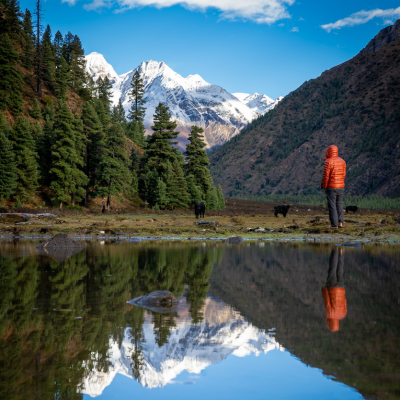 Dolpo
Dolpo
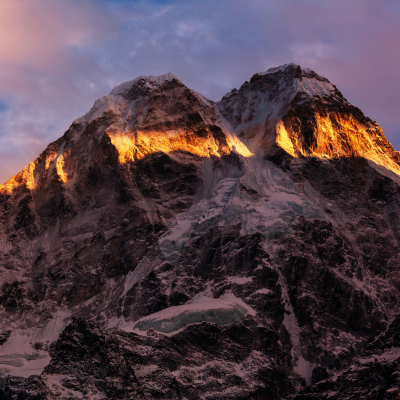 Eastern Nepal
Eastern Nepal
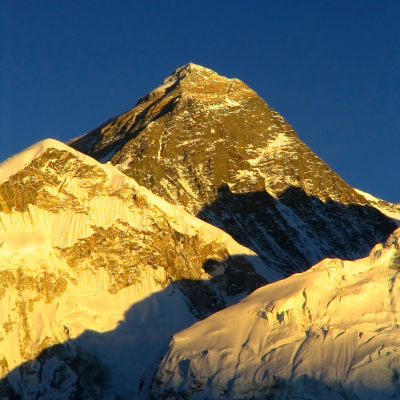 Everest
Everest
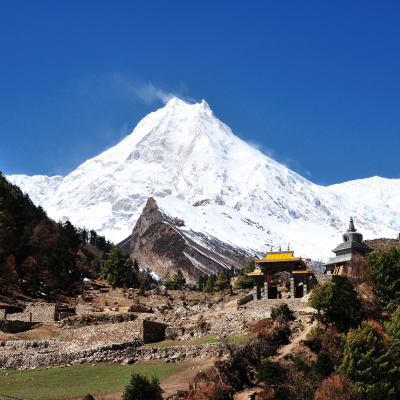 Manaslu
Manaslu
 Western Nepal
Western Nepal
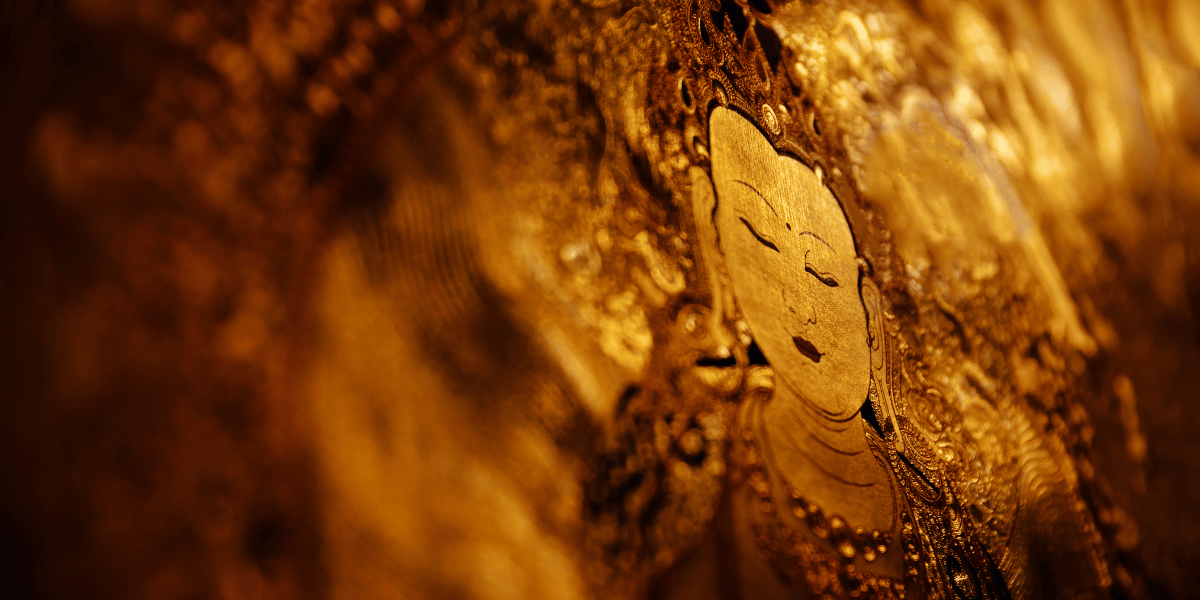
 Altitude Himalaya
Altitude Himalaya